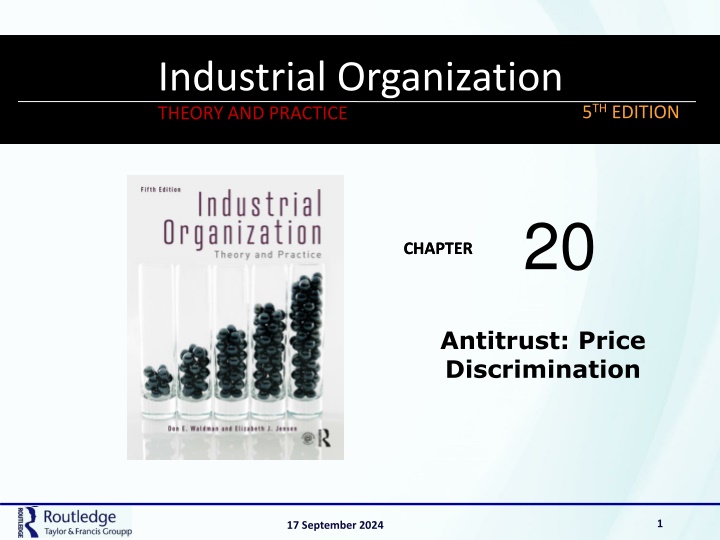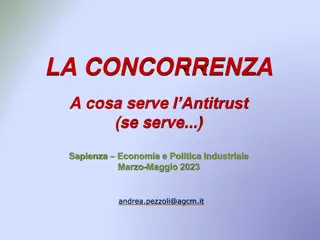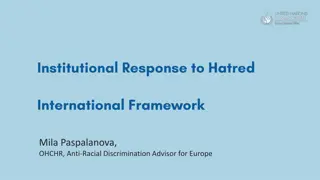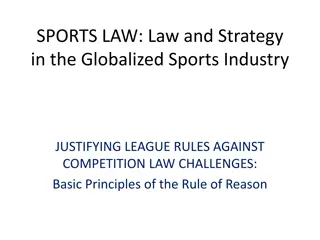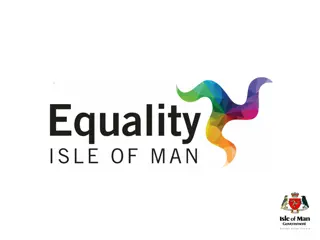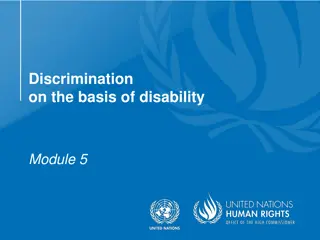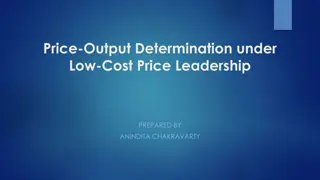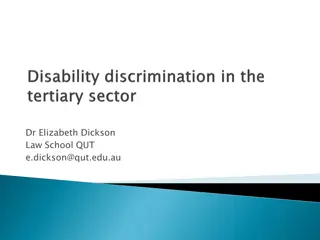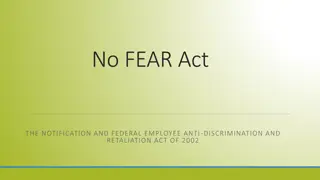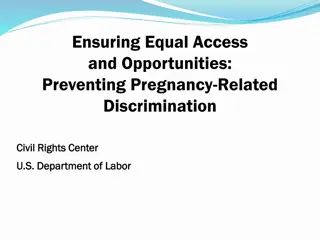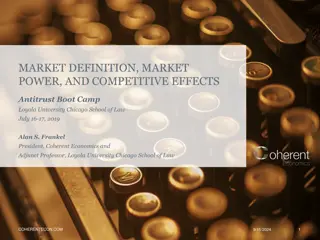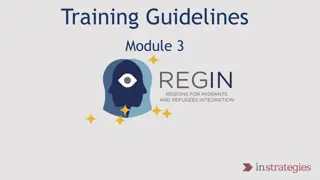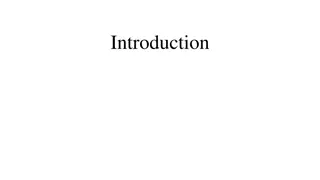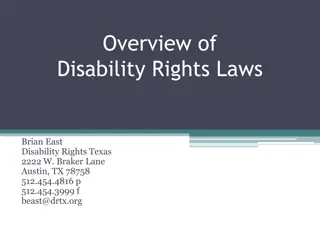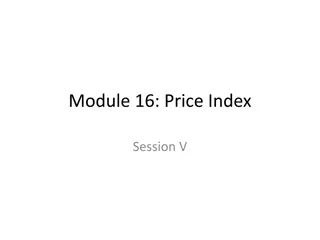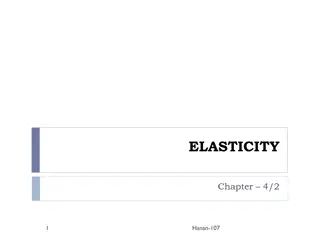Antitrust and Price Discrimination: Robinson-Patman Act Overview
The Robinson-Patman Act, a significant antitrust statute, aims to prevent price discrimination that harms competition, particularly targeting sellers granting discriminatory prices. While some price discrimination can enhance efficiency, predatory discrimination poses a serious threat to competition. Cases under the Act are categorized into primary-line and secondary-line cases, focusing on effects on competition. The Act prohibits price discrimination that may lessen competition or lead to monopoly, requiring proof of injury to competitors or the competitive process. Defenses like cost justification and meeting competition are available but subject to judicial interpretation.
Download Presentation

Please find below an Image/Link to download the presentation.
The content on the website is provided AS IS for your information and personal use only. It may not be sold, licensed, or shared on other websites without obtaining consent from the author.If you encounter any issues during the download, it is possible that the publisher has removed the file from their server.
You are allowed to download the files provided on this website for personal or commercial use, subject to the condition that they are used lawfully. All files are the property of their respective owners.
The content on the website is provided AS IS for your information and personal use only. It may not be sold, licensed, or shared on other websites without obtaining consent from the author.
E N D
Presentation Transcript
MODERN LABOR ECONOMICS THEORY AND PUBLIC POLICY THEORY AND PRACTICE Industrial Organization 12THEDITION 5THEDITION 20 CHAPTER CHAPTER Antitrust: Price Discrimination 1 17 September 2024
20.1 Antitrust: Price Discrimination and the Robinson- Patman Act The Robinson-Patman Act is the most controversial of the antitrust statutes. Passed during the Great Depression, its original intention was to prevent large chain store buyers from inducing suppliers to grant price concessions that were unavailable to small retailers. However, the Robinson-Patman Act has been directed almost entirely at sellers who grant discriminatory prices. The Robinson-Patman Act often protects small competitors rather than the competitive process. Although most temporary or sporadic price discrimination improves efficiency, some predatory discrimination is anticompetitive. This predatory discrimination has the specific aim of weakening or driving competitors from the market, allowing the predator to then raise price above average cost. Most predatory discrimination is systematic and carried out by dominant firms, and it is only this discrimination that offers any serious threat to competition. Unfortunately, the Robinson-Patman Act has rarely been successful in attacking predatory discrimination but, instead, has typically been directed at practices that have few negative effects on competition. Further, at least in theory, true predatory behavior can be attacked under Section 2 of the Sherman Act without reference to the Robinson-Patman Act. 17 September 2024 2
20.1 Antitrust: Price Discrimination and the Robinson- Patman Act Robinson-Patman Act cases are grouped into either primary-line or secondary- line cases according to their effects on competition. Primary-line cases involve possible injury to a direct competitor. Most primary-line cases involve geographic price discrimination. Secondary-line cases involve possible injury to a competitor of a buyer who receives a lower discriminatory price. If Ben & Jerry s sold ice cream to Wegman s at a lower price than to any other store, it might injure Wegman s competitors. The Robinson-Patman Act forbids price discrimination: where the effect of such discrimination may be substantially to lessen competition or tend to create a monopoly in any line of commerce or to injure, destroy, or prevent competition with any person who either grants or knowingly receives the benefit of such discrimination, or with customers of either of them. The Robinson-Patman Act requires injury to either the competitive process or to specific competitors. The act requires only that there may be a substantial lessening of competition, so any price discrimination that may have a negative effect on any competitor at any level of competition, therefore, may be subject to enforcement. The act provided for two major defenses: cost justification and meeting competition, but left standards for either defense open to judicial interpretation. 17 September 2024 3
20.2 Secondary-Line Cases Some of the earliest Robinson-Patman Act cases involved basing point pricing systems. Recall that under a basing point pricing system, or delivered price system, one or more geographic locations are established as basing points. Buyers are charged prices that include standard freight charges from the nearest basing point, even if the seller s manufacturing plant is located far from the basing point. Basing point systems are most common in industries characterized by high transportation costs relative to value, such as steel, cement, and lumber. Two rather obvious questions arise: 1. What does the basing point system have to do with the Robinson-Patman Act? 2. Why not attack these systems under the Sherman Act? Although basing point systems have been successfully challenged under the Sherman Act, the earliest cases were Robinson-Patman Act cases in which the Federal Trade Commission (FTC) argued that buyers located close to a seller but far from a basing point paid higher mill net prices and, therefore, were discriminated against. The first ruling handed down was in 1945, concerning the basing point system in the glucose (corn syrup) industry. 17 September 2024 4
20.2 Secondary-Line Case Corn Products (1945) The Corn Products Refining Company was a large glucose manufacturer that operated plants in Chicago and Kansas City, Missouri. It sold glucose primarily to candy manufacturers, and all sales were made at delivered prices based on a single basing point, Chicago. Candy manufacturers outside Chicago paid a higher price for glucose than Chicago buyers, even if they were located in Kansas City and purchased from Corn Products Kansas City plant. In 1939 the Chicago price was $2.09 per hundred pounds, and the Kansas City price was $2.49 ($2.09 + $0.40 phantom freight from Chicago). The FTC argued that the system discriminated against candy manufacturers located in Kansas City because the net price (net price=price actual freight) in Kansas City was $2.49 compared with $2.09 ($2.09 $0.00) on glucose shipped from Chicago plants to Chicago candy manufacturers. According to the FTC, candy manufacturers located in Kansas City would be injured by this discrimination, and the Supreme Court agreed. The Court ruled that because glucose is a principal ingredient in low-priced candy, differences of even small fractions of a cent in the price of glucose could divert business from one manufacturer to another, and therefore, there was a reasonable probability that the effect of the discriminations may be substantially to lessen competition. 17 September 2024 5
20.2 Secondary-Line Cases Staley (1945) Staley was a glucose producer located in Decatur, Illinois. It competed with the Corn Products Refining Company and also followed a single basing point system based on Chicago delivered prices. When Staley entered the industry in 1920, the basing point system was well established and Staley argued that its adoption of the system was made in "good faith" to meet competition. The Court of Appeals upheld Staley's position but the Supreme Court reversed. The Court ruled that Staley's prices "were established not to meet equally low Chicago prices of competitors there, but in order to establish elsewhere the artificially high prices." The Staley decision established two important precedents: 1. The decision established that it was not an acceptable good faith defense to meet a competitor's illegal discriminatory price. 2. In a later section of the decision, the Court established the future legal standard for judging good faith defenses as the showing "of facts which would lead a reasonable and prudent person to believe that the granting of a lower price would in fact meet the equally low price of a competitor." 17 September 2024 6
20.2 Secondary-Line Cases Cement Institute (1948) The legal death knell for basing point systems came three years after the Corn Products decision in the Cement Institute case.* In the Corn Products case, the Court held that a single basing point system was illegal, but it reserved judgment on multiple basing point price systems because of the good-faith proviso of the Robinson-Patman Act. In the Cement case, the Court held that a seller could not justify the adoption of a competitor s basing point price system under Section 2(b) as a good faith attempt to meet the competitor s equally low price. For all practical purposes, the Cement Institute case ended legal basing point systems in the United States. A per se ban on industry-wide systematic basing point systems seems justified. Basing point systems distort market prices and costs. Furthermore, by encouraging firms to enter basing point industries with stable price structures, the systems may encourage excessive entry and a great deal of excess capacity. Although individual producers may, from time to time, be forced to adopt a delivered pricing system to match local competition, this can be accomplished under a uniform F.O.B. pricing system, with freight absorption by the seller permitted to meet a competitor s lower price. At the very least buyers should have the option of F.O.B. pricing with buyer pickup at the mill. The elimination of most basing point systems has been one of the more positive effects of the Robinson-Patman Act. 17 September 2024 7
20.2 Secondary-Line Cases Morton Salt (1948) Morton Salt was the nation s leading producer of table salt and followed a strict quantity-based system of price discrimination, as shown in the table. Only five large store chain qualified for the top discount and thus could sell at a retail price below the wholesale price that many independent wholesalers paid for salt. Morton argued that because the discounts were available to all purchasers, they were not discriminatory. The Supreme Court ruled against Morton. The majority reasoned that the discounts were theoretically available to all, but that functionally they were available only to the largest chains. In another section of the decision, the Court stated that the statute does not require that the discriminations must in fact have harmed competition, but only that there is a reasonable possibility that they may have such an effect. Two important precedents emerged from the Morton Salt case. First, only a reasonable possibility of injury to competition or competitors was required by the majority, which considerably reduced the burden of proof in Robinson-Patman Act cases. 17 September 2024 8
20.2 Secondary-Line Case Morton Salt (1948), continued Second, the Morton Salt case established that pure quantity-based discounts had to be fully cost justified. The Morton Salt decision can be criticized on economic grounds, as it highlighted the basic conflict that arises in so many Robinson-Patman Act cases. If all price discrimination is eliminated, a firm s output is likely to decline, and average costs will rise as long as economies of scale exist. Eliminating all price discrimination is likely, therefore, to raise society s average cost of producing a good. In addition, consumers may well end up paying higher prices. In the long run, the banning of all quantity discounts may not help even the small retailers the main focus of Congress s concern when the Robinson- Patman Act was passed. If the banning of discounts on salt encouraged the large chains to produce their own salt (that is, to vertically integrate into salt production), then Morton s output would decline, its average costs might increase, and Morton might increase its price to small retailers that were unable to produce their own salt. Under such circumstances, the difference between what large and small retailers pay for salt might increase. 17 September 2024 9
20.2 Secondary-Line Cases Standard Oil of Indiana (1958) The next major secondary-line case involved the other major defense established in the Robinson-Patman Act, the good-faith meeting of competition. Standard Oil had followed a policy of charging four large Detroit jobber-retailers prices that were 1.5 cents per gallon less than prices charged its service station customers. Each of the four jobbers sold some of their gasoline at retail, and two of the jobbers charged lower retail prices than generally prevailed for Standard s gasoline. The four jobbers took deliveries in tank-car quantities of 8000 to 12,000 gallons, rather than the typical tank-wagon quantities of 700 to 800 gallons that were delivered to service stations. Some cost savings were associated with these large-quantity purchases; however, the Commission ruled that the entire 1.5 cent differential could not be cost justified. Once its cost justification failed, Standard argued that the reductions were made in a good-faith effort to meet competition. The Commission ruled that meeting competition was not an absolute defense under Section 2(b). The FTC s argument was a technical one based on Section 2(a) seeming to make only the cost justification an absolute defense, while the meeting competition defense was relegated to Section 2(b), which dealt primarily with the burden of proof in Robinson-Patman Act cases. 17 September 2024 10
20.2 Secondary-Line Cases Standard Oil of Indiana (1958), continued The Supreme Court initially ruled that a good-faith meeting of competition established an absolute defense under the Robinson-Patman Act, and the case was remanded to the FTC for reconsideration of Standard s meeting competition defense. On remand the Commission ruled that Standard had not acted in good faith, but instead was following a simple pricing system in which purchasers of over 2 million gallons a year received a lower price. The case was then appealed for a second time to the Supreme Court. This time the Court found for Standard because it was persuaded by evidence that between 1936 and 1941 local suppliers had made numerous attempts to take business away from Standard by reducing prices to the large jobber-retailers. A major potential problem exists with this decision and with the act in general, as described on the next slide. 17 September 2024 11
20.2 Secondary-Line Cases Standard Oil of Indiana (1958), continued Suppose Sunoco offered an illegal discriminatory price to one of Standard s jobbers. Should Standard be permitted to undercut Sunoco s price? Under the Cement Institute precedent, one would think not. Under the Standard Oil precedent, however, it appears to be legitimate to match even an illegal price. Furthermore, if Standard is permitted to undercut Sunoco s price, should Texaco be permitted to cut Standard s price, and then should Shell be permitted to cut Texaco s price? In other words, after one price cut in good faith is permitted, shouldn t every subsequent price cut be permitted? If the answer is yes, then the act becomes meaningless. The most important precedent emerging from the two Standard Oil Supreme Court decisions was the establishment of the good-faith meeting of competition as an absolute defense in Robinson-Patman Act cases. 17 September 2024 12
20.2 Secondary-Line Cases Borden (1962) The 1962 Borden case concerned the pricing practices of two major distributors of milk in Chicago: Borden and Bowman Dairy, which both charged prices to independent stores that included volume discounts based on daily purchases. In June 1954, Borden established the price schedule shown in the table, and also granted two large chains, A&P and Jewel, a flat 8.5 percent discount. A few large independents also received a 5.5 percent discount. Bowman's discount schedule was similar, but more complex, placing firms in one of 17 discount groups, with discounts ranging from 3 to 8 percent as well as offering A&P and Kroger an 11 percent discount. These pricing policies placed independents into one group with their prices determined by a volume based discount schedule, and two large chains into an entirely separate group. Both firms used a cost justification defense and each introduced a large volume of statistical evidence to support their cost claims. The Supreme Court ruled for the government because Borden's and Bowman's average cost groupings were "too broad." 17 September 2024 13
20.2 Secondary-Line Cases Borden (1962), continued The Borden decision indicates why firms have a great deal of difficulty establishing a valid cost justification defense. The Court stated that price discrimination must be fully cost justified, penny for penny. According to the Supreme Court, if prices differ by $1.00 and a firm justifies a 75 cent, or even 90 cent, cost differential, the defense is likely to fail. Further, cost estimates must be based on average cost estimates, not marginal cost estimates. The average cost of servicing a large buyer is likely to be much higher than marginal cost because average cost includes an allocation for overhead. Therefore, requiring firms to base cost estimates on average cost sets a very stringent standard for the legitimate use of the cost-justification defense. Not surprisingly, given the extreme difficulty of establishing the cost-justification defense, only two completely successful cost justification defenses were accepted in court between 1936 and 1954. 17 September 2024 14
20.2 Secondary-Line Cases Falls City Industries(1983) Falls City Industries was a beer distributor that beer to wholesalers in Indiana, Kentucky, and eleven other states. Because of state regulations in both Indiana and Kentucky, wholesalers could not cross state lines to sell to retailers in other states, but consumers often crossed state lines to purchase beer from the cheaper retailer. Falls City typically charged higher prices, as much as 30 percent higher, in Indiana than in Kentucky. Vanco, a distributor in Indiana, sued Falls City, claiming that Dawson Springs passed its lower prices on to its retailers and that many consumers in Indiana then crossed the border to buy less expensive beer in Kentucky, thereby reducing Vanco s beer sales in Indiana. The District Court and the Court of Appeals found that Falls City had violated the Robinson- Patman Act, rejecting Falls City s defense that it was meeting equally low prices in Kentucky, because the price discrimination was created by raising prices in Indiana rather than lowering prices in Kentucky. Indiana required brewers to charge a uniform price throughout the state, so Falls City had to charge the same price to wholesalers located near the southern Indiana border with Kentucky as they charged to wholesalers hundreds of miles away in northern Indiana. The Supreme Court remanded the case to the District Court to give Falls City an opportunity to prove that its lower prices in Kentucky were made in a good-faith effort to meet the lower prices that prevailed in Kentucky. The Supreme Court ruled that Falls City would have to show that a reasonable and prudent businessman would believe that the lower price he charged was generally available from his competitors throughout the territory and throughout the period in which he made the lower price available. 17 September 2024 15
20.2 Secondary-Line Cases Texaco(1990) Between 1972 and 1981, Texaco sold gasoline to 12 independent retailers in Spokane, Washington. Texaco also sold gasoline to two wholesaler-retailers of gasoline: Gull Oil Company and Dompier Oil Company. Gull sold gasoline under its own name, but Dompier sold gasoline under the Texaco brand name. Texaco sold gasoline to Gull at prices that ranged from 4 to 6 cents below its prices to the 12 independent retailers, and it sold gasoline to Dompier at prices that ranged from 3.65 to 3.95 cents below its prices to the 12 independents. For several years the independents lost sales to Gull and Dompier; in July 1976 the 12 independents sued Texaco. The Supreme Court ruled that Texaco s behavior violated the Robinson-Patman Act. The Court rejected Texaco s argument that Gull and Dompier were wholesalers, not retailers, and therefore that the lower prices were justified to cover the expenses associated with their wholesaler operations. It did not help Texaco s case that both Gull and Dompier generally picked up gasoline from Texaco and immediately resold it to consumers. Another point working against Texaco was the company s refusal to allow the independents to haul their own gasoline from Texaco s storage tanks at lower prices. 17 September 2024 16
20.2 Secondary-Line Cases McCormick Spices(2000) In 2000, the FTC filed a complaint against McCormick & Company, the world s largest supplier of supermarket dry spices, which had a dominant national market share and only a single national competitor. At the time of the filing of the complaint, McCormick had already agreed to a consent decree and that decree was filed simultaneously with the complaint. While McCormick had a single national price list for all its products, almost no buyers paid the list price; prices were individually negotiated, with significant discounts. Discounts included direct cash payments, free products, off-invoice discounts, rebates, and performance incentives. McCormick also sometimes demanded that up to 90 percent of the shelf space allotted to spices in a supermarket had to be devoted to its spices. Its market power was so significant that the individually negotiated contracts were an attempt to use first-degree price discrimination. The FTC charged that on at least five occasions between 1994 and 2000 McCormick discriminated in price by providing preferential payments to some buyers that were not offered to the buyers direct competitors, causing secondary-line injury to competition to the firms that paid the higher prices. The consent decree prohibited McCormick from discriminating in price between buyers unless the discrimination was based on one of the two Robinson-Patman Act defenses, either cost justification or meeting competition. The decree also required McCormick to notify the FTC of any use of price discrimination for 10 years. 17 September 2024 17
20.2 Secondary-Line Cases Volvo(2005) In 2005 the Supreme Court agreed to hear another Robinson-Patman Act case on appeal from the Eighth Circuit Court of Appeals. Reeder-Simco (hereafter Reeder) sells heavy-duty trucks in Arkansas. Most heavy-duty trucks are manufactured after a customer has requested bids from several truck retailers and the customer has accepted one of the bids. During the bidding process, it is common practice for the retailers to solicit discounts from the manufacturers so that the retailer can offer lower prices. Reeder claimed that in violation of the Robinson-Patman Act, Volvo systematically offered other Volvo dealers larger discounts and these larger discounts prevented Reeder from obtaining sales. Reeder argued that these varying discounts were part of Volvo s plan to eliminate many of its dealers, based largely on n an e-mail that Volvo sent to all its dealers in December 1997. The e-mail announced a new policy called Volvo Vision and stated that there were too many Volvo heavy-duty truck dealers and many of the current dealers were underperforming and that Volvo s objective was to reduce the number of dealers from 146 to 75. After receiving the Volvo Vision e-mail, Reeder accidentally was sent a number of faxes that showed Volvo offered larger discounts to other Volvo dealers. For example, in 1999, Reeder requested a 12 percent discount on a sale of 12 trucks to Hiland Dairy, but Volvo offered Reeder a 7.5 percent discount while offering another dealer (who obtained the contract) an 8.5 percent discount. Reeder also argued that even on bids that it won, it would have earned higher profits if it had received the same discounts that Volvo offered to other dealers. 17 September 2024 18
20.2 Secondary-Line Cases Volvo(2005), continued A District Court jury ruled in favor of Reeder and awarded the plaintiff over $5.6 million in treble damages. Volvo s defense was centered on the issue of whether or not an unsuccessful bidder is a purchaser in the eyes of the law. For example, with regard to the Hiland Dairy contract, the trucks were purchased by the other dealer, not Reeder, so since Reeder did not purchase the trucks from Volvo, Volvo could not be held liable for a Robinson-Patman Act violation. The Eighth Circuit Court rejected Volvo s argument because: 1. Prior precedent recognized that if a plaintiff s failure to purchase is directly attributable to the defendant s discriminatory pricing practice, then the defendant is liable to attack under the Robinson-Patman Act. 2. There was evidence that on at least four occasions, Reeder purchased Volvo trucks following successful bids for contracts but received smaller discounts than other Volvo dealers received for the same trucks manufactured and sold at the same time, which harmed Reeder s profits. By a 3-2 vote, the Court of Appeals upheld the jury s award against Volvo. In 2006, however, the Supreme Court in a 7-2 decision reversed and remanded the case back to the District Court. In a rather narrow ruling, the majority decided that Volvo could not be held liable for price discrimination between its dealers without a showing that the dealers actually competed against each other to sell the exact same truck to the same retail customer. 17 September 2024 19
20.3 Primary-Line Cases Primary-line cases deal with injury to direct competitors and are more likely to involve charges of predatory conduct than secondary-line cases. The cases in this section deal with charges of geographic discrimination where large national firms charged different prices in different sections of the country. Because competitive conditions can vary across geographic regions, these cases again suggest that the law may protect competitors rather than competition. Anheuser-Busch(1961) In 1954, Anheuser-Busch lowered the price of Budweiser in St. Louis below the price it charged elsewhere. The FTC ruled that this violated the Robinson-Patman Act, but the Seventh Circuit Court of Appeals held that the threshold statutory element of price discrimination had not been established. The Circuit Court argued that because Anheuser-Busch charged the same price to all purchasers in St. Louis, there had been no price discrimination. The Supreme Court overturned the Appeals Court. Chief Justice Warren stated it is certain at least that Section 2(a) is violated where there is a price discrimination which deals the requisite injury to primary-line competition, even though secondary-line and tertiary-line competition are unaffected. Having established that geographic discrimination came within the jurisdiction of the Robinson-Patman Act, the Supreme Court remanded the case to the Appeals Court for further consideration. 17 September 2024 20
20.3 Primary-Line Cases Anheuser-Busch(1961), continued The facts were straightforward. Before its first price decrease, Anheuser-Busch controlled 12.5 percent of the St. Louis beer market. After two price cuts, which lowered Budweiser s prices to equal its competitors prices, Budweiser s market share increased to 39.3 percent. The price reductions lifted Budweiser from fourth place (last among the majors) to first place in the St. Louis market, but when Anheuser-Busch increased its prices in March 1955, Budweiser s market share declined to 17.5 percent. The Circuit Court of Appeals dismissed the case for a second time, ruling that Anheuser-Busch s price discrimination had not caused any injury to competition. The Court of Appeals was persuaded by evidence that Anheuser-Busch s competitors continued to control more than three-fourths of sales in the 12 months after the price of Budweiser was voluntarily increased in St. Louis in March 1955. The Court also noted that the primary beneficiaries of Anheuser-Busch s price reductions were St. Louis consumers. The Circuit Court recognized that Anheuser-Busch s price reductions improved efficiency by bringing price closer to marginal cost and giving consumers a wider choice of popularly priced beers. Furthermore, the Court implicitly recognized that market competition on a local, rather than national, level determines beer prices. 17 September 2024 21
20.3 Primary-Line Cases Utah Pie(1967) The Utah Pie decision is one of the most controversial antitrust decisions. Utah Pie was a small company that had been baking fresh pies for 30 years when it entered the frozen pie market in 1957. Utah Pie quickly captured 66.5 percent of the Salt Lake City market. Three large national firms, Pet Milk, Continental, and Carnation, also sold frozen pies in Utah. The case centered on the response of the three national firms to Utah Pie s domination of the Salt Lake City market. Pet Milk produced frozen pies in California and Pennsylvania, yet its pies sometimes were selling at significantly lower prices in Salt Lake City than in markets located closer to Pet s manufacturing plant in California. Similarly, in June 1961 Continental offered its large apple pies at $2.85 per dozen in Utah, a price well below its apple pie prices in other markets. Evidence suggested that the $2.85 price may have been below its direct cost plus an allocation for overhead. Finally, in 1959 Carnation cut its price by 60 cents per dozen in Utah, and the Supreme Court concluded that at this price, Carnation was selling pies at prices below average total cost. 17 September 2024 22
20.3 Primary-Line Cases Utah Pie(1967), continued However, there is another side to the case. The Supreme Court believed that each of the three national firms showed some evidence of predatory intent. Evidence suggested that Pet Milk went so far as to send an industrial spy into Utah Pie s plant. Furthermore, although prices always covered marginal costs, there was serious doubt that they always covered average total costs. Finally, below-cost pricing can clearly be used by large national firms in local markets to attempt to destroy local competition. If such behavior is always permitted, it might result in long-run problems because a few large national firms could come to dominate many markets by establishing a tough reputation. The Utah Pie decision resulted in a great deal of criticism from economists and was a major impetus for the seminal article by Areeda and Turner in which they argued that only prices below marginal cost should be considered predatory. Since marginal costs are difficult to calculate, Areeda and Turner advocated using average variable cost as a proxy for marginal cost. This position was in turn criticized by many economists who argued that it was extreme. Critics noted that carrying this recommendation to its logical conclusion, only prices below average variable cost are predatory, which implies that only prices below a firm s short-run shutdown price are predatory, but virtually all price discrimination actually takes place at prices well above average variable costs. 17 September 2024 23
20.3 Primary-Line Cases Vebco (1975) Vebco was primarily a distributor of air conditioning and heating equipment in El Paso, Texas, and American Excelsior (AMXCO) was the world's largest manufacturer of evaporative cooler pads for air conditioners. Beginning in 1953 and continuing through 1969, the only cooler pads distributed by Vebco were produced by AMXCO. In 1969 AMXCO learned of Vebco's plans to manufacture its own pads and terminated its supply relationship with Vebco. Two years later, in 1971 AMXCO offered a 25 percent discount in El Paso, which placed its El Paso prices considerably below its prices in other markets. As a result of AMXCO's price cuts, Vebco filed a suit against AMXCO in 1971 under the Robinson Patman Act, and it later filed a Sherman Act claim as well, relying on evidence of lost profits and predatory intent. A District Court jury found in favor of AMXCO, and Vebco appealed. The Fifth Circuit Court of Appeals, relying heavily on the Areeda and Turner doctrine, affirmed the District Court decision. Judge Morgan wrote, "It is frequently quite difficult to calculate...marginal cost. ... Consequently, the firm's average variable cost may be effectively substituted for marginal cost in predatory pricing analysis." Since the Court of Appeals determined that AMXCO's prices were well above average total cost, the Court dismissed the charges. 24 17 September 2024
20.3 Primary-Line Cases Vebco (1975), continued The facts in the AMXCO case were somewhat similar to those in the Utah Pie case, but the decision relied on the Areeda and Turner doctrine instead of the Utah Pie precedent. Under this doctrine, Utah Pie would certainly have lost its case because its competitors' prices were always above marginal cost and average variable cost. The AMXCO decision can be defended on efficiency grounds. The widespread adoption of the average variable cost test, however, may result in significant problems as even the most aggressive predatory behavior could be justified. Such a position could have its greatest impact in monopolization cases. Even the 1911 Standard Oil and American Tobacco decisions might have been overturned based on strict adherence to the Areeda and Turner doctrine. 17 September 2024 25
20.3 Primary-Line Cases General Foods(1984) General Foods, the producer of Maxwell House coffee, responded aggressively to the East Coast entry of Procter & Gamble, the producer of Folgers coffee. In 1970 General Foods held approximately a 43 percent national market share for non- instant coffee, mostly held by Maxwell House. In 1971 Procter & Gamble began to market Folgers in the East by selling in four test markets. In response to Folgers s entry, General Foods greatly reduced the price of Maxwell House in the test markets. Evidence suggested that Maxwell House was sold at prices below marginal and average variable costs. In the late winter of 1974, for example, Maxwell House was sold for $2.095 per three-pound can in Pittsburgh, whereas the price of a three-pound can of unroasted green coffee beans was $2.10. Despite the evidence of below-cost pricing, the FTC dismissed the case because o injury to competition had been proved. The Commission noted, The principal effect of the heated rivalry between Folgers and Maxwell House has been to reduce the prices consumers pay for coffee and promote product quality. . . . Healthy competition does not violate the Robinson- Patman Act. Evidence of prices below average variable cost was still not sufficient to result in a finding in support of the FTC staff. 17 September 2024 26
20.3 Primary-Line Cases Borden Private Label (1967) The 1967 Borden decision concerned the issue of private label pricing. Borden sold its evaporated milk under its Borden brand label and also under private labels such as A&P; although the milk was physically identical, Borden charged a higher price for the Borden brand. The FTC complained that the practice violated the Robinson Patman Act, but the Fifth Circuit Court of Appeals put aside the Commission's cease and desist order on the ground that private label milk "as a matter of law" was not of the same grade and quality as branded milk. The Supreme Court overturned the Circuit Court and declared that "there is nothing in the language of the statute indicating that grade, as distinguished from quality, is not to be determined by the characteristics of the product itself, but by consumer preferences, brand acceptability or what customers think of it and are willing to pay for it." On remand, however, the Circuit Court of Appeals ruled that Borden's private label business had not injured competition, stating that: "where a price differential between a premium and non premium brand reflects no more than a consumer preference for the premium brand, the price difference creates no competitive advantage to the recipient of the cheaper private brand product on which injury could be predicated." From an economic perspective, the Circuit Court's decision makes more sense than the Supreme Court's position because consumers must consider branded products to be different from private label products; otherwise their prices would be identical. 17 September 2024 27
20.4 Illegally Induced Price Discrimination The Robinson-Patman Act was passed in large part to prevent major chain stores with monopsony power from inducing lower prices from suppliers, but very few successful cases have been filed under Section 2(f), which deals with this issue. Automatic Canteen (1953) Automatic Canteen operated more than 230,000 candy vending machines, so it purchased a great deal of candy and thus was able to request lower prices from its candy suppliers under the threat of cutting off its purchases. Automatic Canteen would often estimate its suppliers cost savings on large- quantity sales to Automatic Canteen and then inform its suppliers of the prices it would find acceptable. Evidence suggested that this was a classic attempt by a large buyer to induce price concessions from suppliers, precisely the problem Congress had in mind when it passed the Robinson-Patman Act. The Supreme Court, however, ruled in favor of Automatic Canteen, concluding that a buyer was not liable under the Robinson-Patman Act if the induced lower prices were either within one of the seller s defenses such as the cost justification or not known by him to be within one of those defenses. In the Automatic Canteen case the Court essentially stated that ignorance of the law was a defense and making a successful prosecution very unlikely. 17 September 2024 28
20.4 Illegally Induced Price Discrimination A&P (1979) In 1965 A&P solicited a bid from Borden to supply A&P s 200 Chicago stores with private-label milk. Borden offered a plan that would have saved A&P $410,000 a year, but A&P was dissatisfied with the offer and solicited a competitive bid from Bowman Dairy. Bowman made a bid that would have saved A&P $737,000 a year. A&P s Chicago buyer then informed Borden, I have a bid in my pocket. You [Borden] people are so far out of line it is not even funny. You are not even in the ball park. A&P s buyer also told Borden that a $50,000 further reduction would not be a drop in the bucket. Borden then offered an $820,000-a-year discount. When it made this offer, Borden emphasized that it was only attempting to meet Bowman s offer. The FTC ruled that because A&P knew that it was the beneficiary of an illegally low price, it had violated Section 2(f). The Second Circuit Court of Appeals affirmed the FTC order, but the Supreme Court overturned it. Justice Stewart wrote that since Borden had a meeting-competition defense and thus could not be liable under Section 2(b), the petitioner who did no more than accept that offer cannot be liable under Section 2(f). 17 September 2024 29
20.4 Illegally Induced Price Discrimination One of the ironies of the Robinson-Patman Act is the minuscule number of cases filed under Section 2(f), although illegally induced price discrimination was one of the major Congressional concerns. Between 1936 and 1966, only 0.03 percent of all cases--were Section 2(f) cases. Criticism of the Robinson-Patman Act by economists and judges has had a major impact on enforcement, greatly reducing the number of cases filed by the FTC. The FTC filed 219 Robinson-Patman complaints in 1963 alone, but it filed only two cases in 1975, six cases between 1975 and 1982, and one case between 1983 and 1987. As a total percentage of all non-merger cases, Robinson-Patman Act cases made up a 64.7 percent of all FTC cases filed under Presidents Kennedy and Johnson between 1961 and 1968, but declined to 5.1 percent of cases under Nixon/Ford (1968-76), then to 2 percent under Carter (1977-1981), 0.6 percent under Reagan (1981-1989), 0 percent under Bush I (1989-1993), 0.1 percent under Clinton (1993-2001), and 0 percent under both Bush II (2001-2009) and Obama (2009- 2017). Today the law survives because private antitrust suits like the Volvo case continue to be filed under the Robinson-Patman Act. As long as the Robinson-Patman Act remains part of US antitrust law, private cases will continue to be filed and keep the act alive in the federal courts. Despite all the criticism of the Robinson-Patman Act, Congress has never shown any inclination to repeal it. 17 September 2024 30
